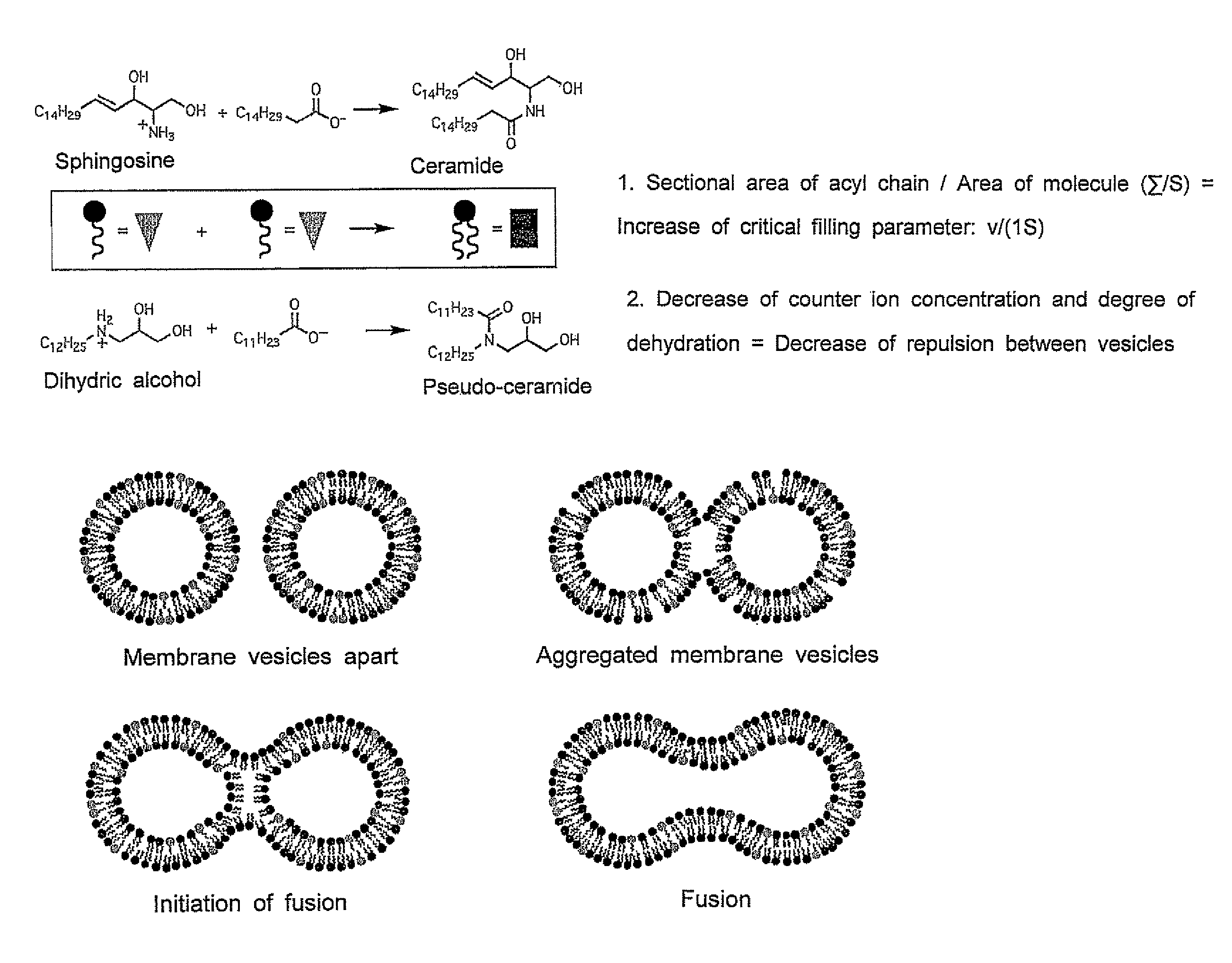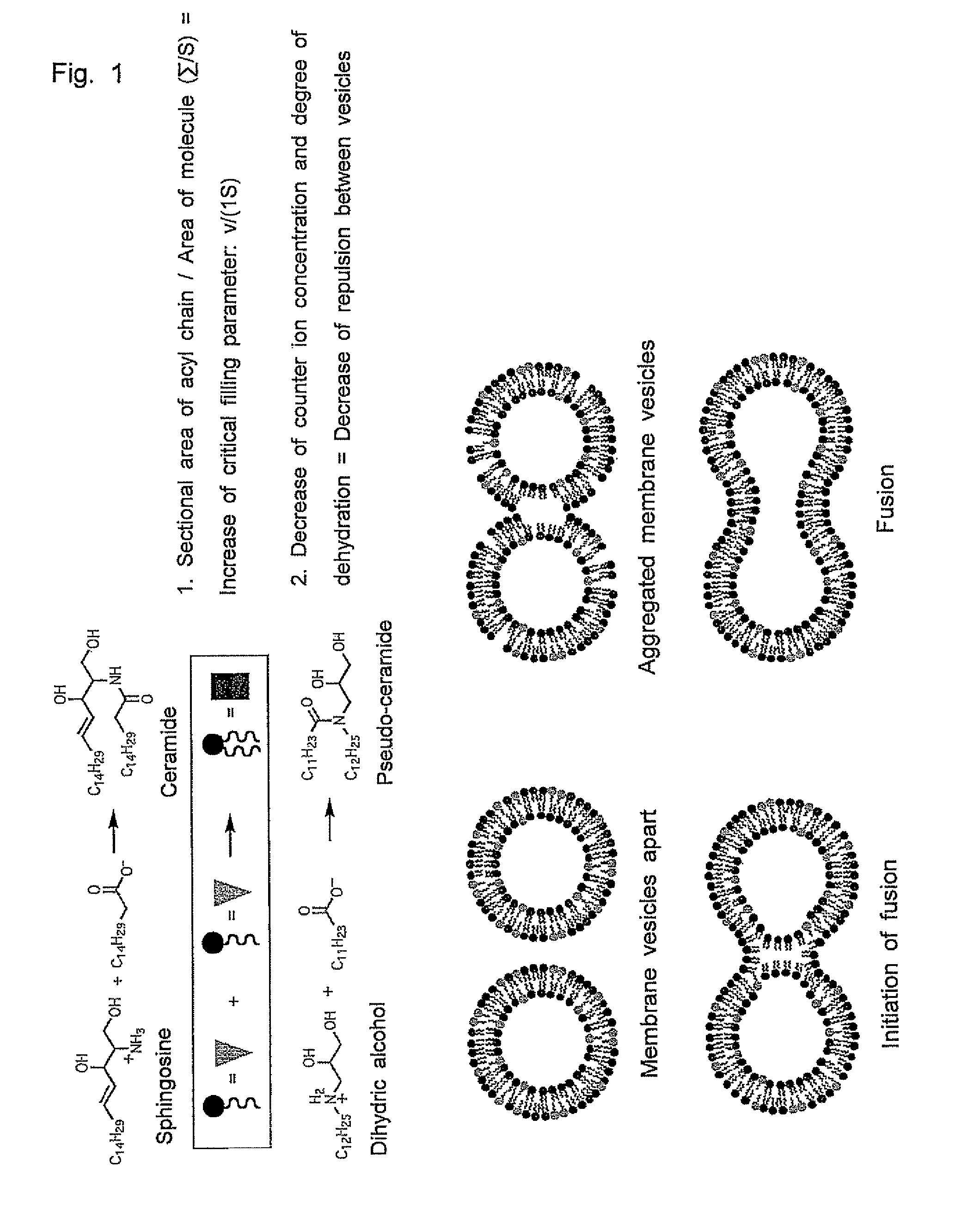Molecular aggregate capable of undergoing phase transition by dehydrating condensation and method of phase transition thereof
a technology of phase transition and molecular aggregate, which is applied in the field of molecular aggregates, can solve the problems of membrane fusion and fission, the inability to employ the method of liposome composed of only neutral phospholipids, and the unstable membran
- Summary
- Abstract
- Description
- Claims
- Application Information
AI Technical Summary
Benefits of technology
Problems solved by technology
Method used
Image
Examples
manufacturing example 1
Synthesis of a Dihydric Alcohol
[0101]As shown in Scheme 1 below, a pseudo-sphingosine that is an amine having two hydroxyl groups as polar groups was synthesized by reacting a glycidol epoxide with a long-chain primary amine, which constitutes a liposome and is used as a substrate for dehydrating condensation within the liposome.
[0102]
[1-1] Synthesis of 3-octylamino-1,2-propanediol (Dihydric Alcohol 1A)
[0103]n-Octylamine (3.0 g, 0.023 mol) was placed to a reaction vessel and heated to 85° C. Glycidol (1.56 g, 0.021 mol) was added thereto over 10 minutes under nitrogen gas stream and stirred for one hour, then the reaction mixture was dried in a vacuum. The resultant residue was subjected to column chromatography, developed with chloroform:methanol=1:1 (1% trimethylamine added), and then eluted and fractionated with methanol (1% trimethylamine added) to give dihydric alcohol 1A (1.03 g, yield 24%).
[0104]colorless crystal; melting point: 59.5 to 61.5° C. 1H NMR (CDCl3) δ 0.87 (t, J=6....
manufacturing example 2
Synthesis of Pseudo-ceramide
[0111]Because the product by the dehydrating condensation in the liposome is thought to be a pseudo-ceramide (Scheme 2), a pseudo-ceramide was synthesized according to the method of Kunishima et al. described above as a sample in order to confirm the findings.
[0112]
[2-1] Synthesis of 3-(N-lauroyldecylamino)-1,2-propanediol (Pseudo-ceramide 2B)
[0113]Sodium laurate (0.25 g, 1.13 mmol) was placed to a reaction vessel, and methanol (6 mL) was added thereto. The dihydric alcohol 1B that was obtained in [1-2] above (0.29 g, 1.13 mmol) was dissolved in methanol (4 mL) and added. DMT-MM (0.34 g, 1.24 mmol) was dissolved in methanol (2 mL) and added, and then this mixture was stirred at room temperature for five hours. The methanol was evaporated under reduced pressure with a pump, and then the residue was extracted using ethyl acetate and distilled water. The ethyl acetate layer was collected, washed twice with saturated sodium carbonate solution, once with disti...
manufacturing example 3
Synthesis of Tertiary Amine Capable of Accumulating at an Interface
[0117]
[3-1] Synthesis of N,N-dimethylamino-acetate-1-dodecyl Ester (C12-tertiary Amine)
[0118]First, 1-dodecyl alcohol (2.98 g, 0.016 mol), triethylamine (1.62 g, 0.016 mol) and 4-(N,N-dimethylamino)pyridine (DMAP; 0.195 g, 0.0016 mol) were added to a solution of N,N-dimethylglycine hydrochloride (2.23 g, 0.016 mol) in dry N,N-dimethylformamide (DMF; 100 mL) under nitrogen atmosphere, and cooled to 0° C. Then, dicyclohexylcarbodiimide (DCC; 3.63 g, 0.0176 mol) in dry DMF (60 ml) was added thereto at 0° C. The reaction mixture was returned to room temperature and stirred for about one day, then DMF was evaporated under reduced pressure with a pump. The residue was dissolved using ether and aqueous saturated sodium bicarbonate solution, and the ether layer was collected and washed once with water and once with saturated saline, after which it was dried over anhydrous magnesium sulfate, and then the solvent was removed u...
PUM
| Property | Measurement | Unit |
|---|---|---|
| size | aaaaa | aaaaa |
| size | aaaaa | aaaaa |
| pH | aaaaa | aaaaa |
Abstract
Description
Claims
Application Information
 Login to View More
Login to View More - R&D
- Intellectual Property
- Life Sciences
- Materials
- Tech Scout
- Unparalleled Data Quality
- Higher Quality Content
- 60% Fewer Hallucinations
Browse by: Latest US Patents, China's latest patents, Technical Efficacy Thesaurus, Application Domain, Technology Topic, Popular Technical Reports.
© 2025 PatSnap. All rights reserved.Legal|Privacy policy|Modern Slavery Act Transparency Statement|Sitemap|About US| Contact US: help@patsnap.com



